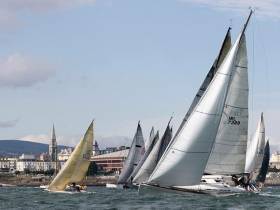Displaying items by tag: Cork Dinghy Fest
2017 Irish Sailing Fixtures Preview
The only non-elitist thing about the Olympic Games is the fact that all countries – however large or small – are treated equally. A small country like Ireland is entitled to exactly the same number of places in competition as the superstates like the US or China. But apart from that, if any country’s national authority in any Olympic discipline is not treating its selected athletes as a pampered elite as an Olympic year arrives, then it is wasting everyone’s time. That’s how it should be in an Olympic year. But things definitely aren’t the same in the three clear years between each Olympiad. W M Nixon looks ahead to a completely different type of season in 2017.
Irish sailing had a good 2016 Olympics. Our waterborne elite did well - they did us proud. And the Irish national sailing season of 2016 – as we saw in last weekend’s review here – was special in many ways, for on top of Olympic success we staged two major world dinghy championships, witnessed perhaps the best ever Volvo Round Ireland Race, and brought home both silver and bronze medals from world youth championships.
That was how it was in 2016. But for 2017, we look forward to a very different kind of sailing year, in which everyone has the chance to be a star at local level, and our Olympic achievers and international medallists will be sailing as ordinary competitors along with everyone else.
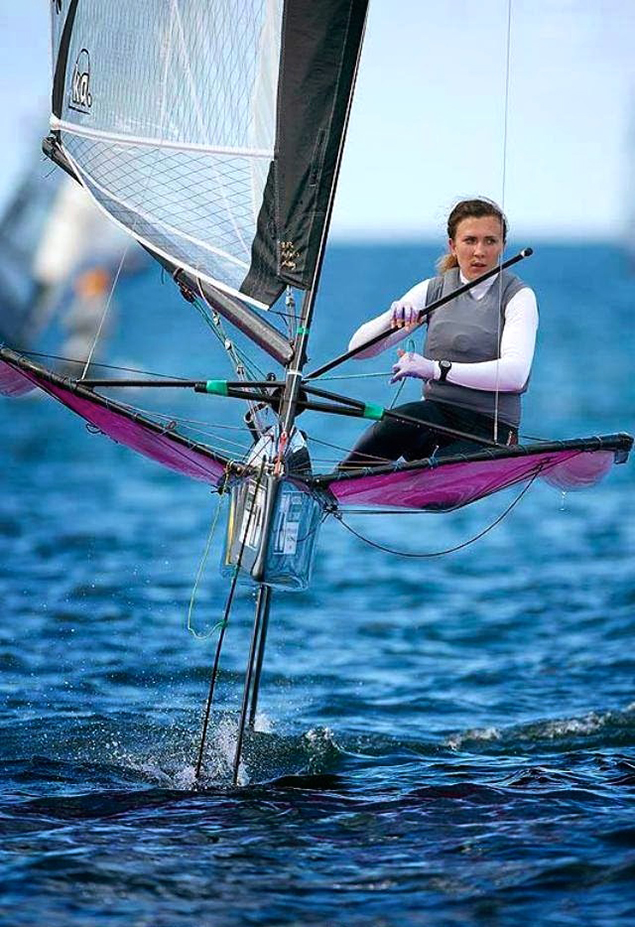 Olympic Silver Medallist Annalise Murphy racing her foiling Moth, with which she is expected to compete in the Cork Dinghy Fest at the end of June. Photo: VDLR
Olympic Silver Medallist Annalise Murphy racing her foiling Moth, with which she is expected to compete in the Cork Dinghy Fest at the end of June. Photo: VDLR
In these circumstances, it’s intriguing to look at some of the events which will set the tone for the coming year. And if by some chance you’re feeling jaded as we sink into the depths of winter, rest assured that it’s an absolute tonic to talk with the voluntary organisers who are heading up the groups which are putting together the various packages which will provide sailing happenings of all sizes from one end of the country to the other.
These people have a level of infectious enthusiasm which, if you could bottle it, would make you a fortune. Their zest in our sport, and their joy in boats and the sailing of them, is a wonder to behold. And they’re so keen on it that they’re prepared to put in so very many hours of their free time – hours beyond measure, in fact – in administrative effort, that it would put many professional organisers to shame.
Such enthusiasm can bring its own special problems. Every sailing centre round the coast and on the lakes will expect its share of the action. So inevitably there will be a clashing of dates which will make for difficult choices for crews who had specific programmes in mind. But this morning, we’re not in the mood to beat the drum about ruthlessly rationalising the national programme. Let’s just tell you what’s happening, and you can draw your own conclusions and plan out your own season.
That said, the big one is undoubtedly the Volvo Dun Laoghaire Regatta from the 6th to 9th July. 2015’s staging of this biennial festival experienced a quantum leap in the scale and scope of the event. Somehow, it moved onto a new plane. Under the chairmanship of Tim Goodbody, the organising committee built on the efforts of previous years, and the resulting myriad of sailing became a wonder to behold, and a joy to take part in. The plan for 2017 is to make it even better.
This outline hints at the scale of the event which will take place in July:
Volvo Dun Laoghaire Regatta 2017
Racing open to 30 Classes.
Incorporating the following Championships:-
· Royal Dee Yacht Club Irish Sea Offshore Championship
· Sigma 33 and Wayfarer National Championships
· Beneteau 211 Irish Championship
· GP14 and 420 Leinster Championships
· SB20 Southern Championship
· J24 & Squib East Coast Championships
Celebrating 200 years of Dun Laoghaire Harbour:
The Kingstown 200 Trophy for the best classic keelboat/dinghy.
NOR and Online Entry will open mid November (Monday November 14th).
Super Early Bird Entry Prize Draw: All entries received and paid for in full by 31 December 2016 will automatically be entered into a Super Early Bird Prize Draw and 10% of these lucky people will have their Entry Fee refunded.
To get the flavour of it, a chat with Organising Chairman Tim Goodbody at mid-week brought everything to life. That said, he was in a thoughtful mood, as that morning he had sold his much-loved Sigma 33 White Mischief after seventeen very happy and successful years. This enthusiasm in talking about their boats was found to be a shared characteristic of all the voluntary organisers, something which those who think the future of sailing lies in group-owned professionally-maintained boats might like to ponder.
Be that as it may, the J/109 class in Ireland will be taking on board the fact that their newest star entrant Tim Goodbody is now a hundred per cent J/109 man. For until he was comfortable in the knowledge that his Sigma 33 White Mischief had gone to a good home (she has found a lucky owner in Arklow), you had the feeling that a tiny bit of his mind was elsewhere as he campaigned the new White Mischief, a J/109.
 No longer a fleet owner…..Tim Goodbody’s J/109 White Mishcief is now his only racing steed. Photo: Afloat.ie
No longer a fleet owner…..Tim Goodbody’s J/109 White Mishcief is now his only racing steed. Photo: Afloat.ie
That said, he was frequently on the podium in the new class, but for Volvo Dun Laoghaire Regatta 2017 the rest of his crew will have to race as best they can without him, for he throws himself so thoroughly into heading up the large army of VDLR volunteers – with Ciara Dowling as an awesomely effective Executive Secretary – that there simply isn’t the time to think of campaigning in one of the hottest of the 30 classes as well.
A look at the heights of the 2017 programme shows how it is quite an achievement for the Volvo Dun Laoghaire Regatta 2017 to be the peak event at home, and it also reveals the difficulty for planning a programme for your boat and crew which will keep everyone – including the Commodore of your home club – in a happy frame of mind.
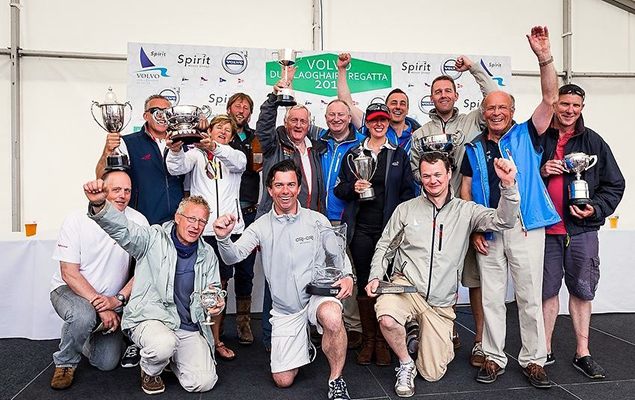
This list is by no means complete, but if you haven’t firmed up your club or association schedule by November, you’re not going to be taken seriously, as November is traditionally the month when the next year’s Corinthian crewing programmes take shape.
2017 Preliminary Programme
March 25th Horizon Energy Group PY1000 in Owenabue River at Crosshaven (RCYC)
May 26th – May 29th Scottish Series (Clyde Cruising Club)
June 3rd Lambay Races (Howth)
June 9th- June 11th ICRA Nats (Royal Cork)
June 14th Dun Laoghaire to Dingle Race (National YC)
June 21st to 24th Sovereigns Cup (Kinsale)
June 30th – July 2nd Cork Dinghy Fest 2017
July 6th to 9th Volvo Dun Laoghaire Regatta
July 6th to 8th WIORA Championship, Aran Islands
July 23rd to 28th Glandore Classics
August 1st to 4th Calves Week (Schull)
August 6th 2017 Rolex Fastnet Race
August 14th – 18th Half Ton Classic Worlds (Kinsale)
October 21st Rolex Middle Sea Race
We happen to know about the first rather esoteric major event on the programme, the PY 1000 dinghy race in the Owenabue River at Crosshaven on March 25th, thanks to the enthusiasm of Nicholas O’Leary of Royal Cork. He’s back on home ground and busy with being the third generation of his family in the energetic and imaginative organisation and promotion of sailing.
The Horizon Energy Group PY 1000 is a come-all-ye for dinghies using the Portsmouth Yardstick handicap. And they don’t mess about with prizes – there’s €1,000 on it. As the tides suit, they’ll be using the full available length and breadth of the Owenabue River between Crosser and Carrigaline in a crazy sailing project to blow the winter cobwebs away, and it will be a useful training for ogranisational energy levels as young O’Leary puts his team through their paces in training for the Cork Dinghy Fest at the end of June.
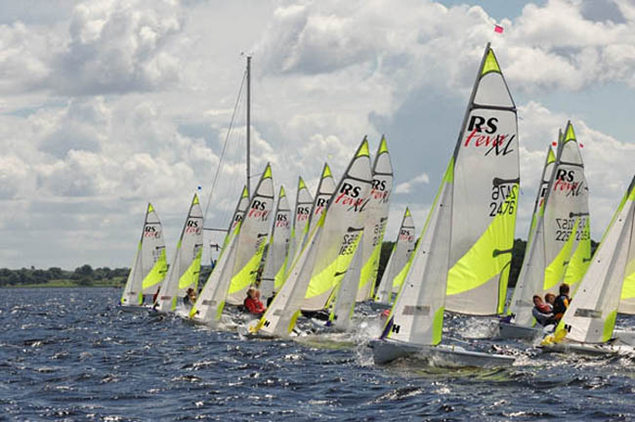 RS Fevas in a National Championship on Lough Ree. They’ll be gathering with other classes in Cork at the end of June 2017
RS Fevas in a National Championship on Lough Ree. They’ll be gathering with other classes in Cork at the end of June 2017
Like Tim Goodbody, he can be slightly sentimental about his boats – in his case, it was seeing an old and much-loved Optimist he’d once raced which fired him up to spread the news. An email from him this week gets the flavour of Nicholas O’Leary’s approach to sailing:
“Top of the organisational agenda is taking on the Dinghy Festival at the end of June on behalf of the Royal Cork Yacht Club and the dinghy fraternity of Ireland and beyond. My good friend Marty O’Leary is chairman of the RS Class in Ireland, and we will again welcome three fleets from under his wing - The RS200 for their Nationals and the RS400 and Feva Southerns.
The array of dinghy classes within Ireland concentrate on doing their own calendar year after year. This is a huge undertaking and requires massive dedication by class captains, regional reps and the clubs that host. The Dinghy Fest takes the stress off such class reps for one of many events they would normally have to organise, and brings together the masses into one harbour to enjoy great racing and great craic ashore, particularly as it provides socialising with friends they haven’t seen due to other class commitments.
We are working on connections within the variety of classes nationwide, and one exciting grouping that we’re planning is an Extreme Fleet. To see one 49er screaming across Cork Harbour is a sight, but we plan to have one race course dedicated to an entire fleet of fast dinghies, with the foiling Moths - where we hope to see Olympic Silver Medallist Annalise Murphy racing against her coach Rory Fitzpatrick - as well as 29ers and 49ers, and the Cat class, with the Catamarans demonstrating their viable concept of mixed craft racing on the one race track, and results divided thereafter.
I know this Extreme Fleet will open the eyes of young sailors to see that there is life after an Optimist, 420, Laser or whatever fleet they are currently in, and that fast fun boats are accessible classes, alive within Irish waters. I sincerely think it’s very important for the future of youth sailing that they enjoy it, finding a class they are happy in rather than being marched up to the gates of a pathway and pushed through. Those who enjoy the sport will stay in the sport. If they excel to greater heights, then so much the better, but that shouldn’t be the be-all and end-all for everyone.
I don’t believe the success of an event is within its number of entries, but in its quality of racing provided. That is why my old housemate and current ISA Champion of Champions Alex Barry is joining our team in an advisory role to keep the high standard of racing up to scratch, and in line with what we would expect when racing Worldwide. I look forward to developments in the months to come, and will of course keep everyone updated with sailing news from near and far.”
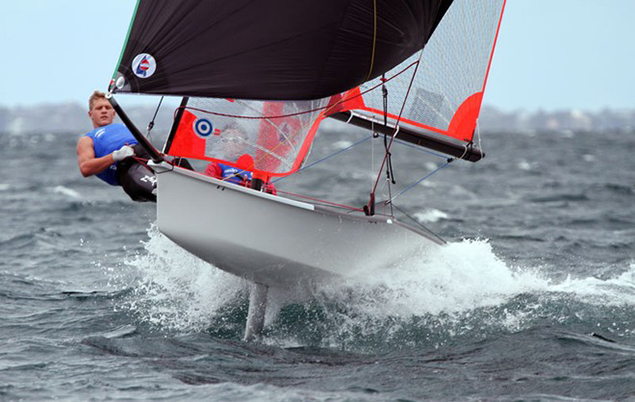 29er in flight. Nicholas O’Leary, organiser for Cork Dinghy Fest 2017, hopes that the presence of 29ers will encourage more young sailors to realize that boats like this aren’t only for the elite
29er in flight. Nicholas O’Leary, organiser for Cork Dinghy Fest 2017, hopes that the presence of 29ers will encourage more young sailors to realize that boats like this aren’t only for the elite
So the dinghies of Ireland have the good example of somebody thinking in a far-sighted and coherent way. But with the offshore racers, the picture is as ever more complex. Yet it’s for sure we’re interested in the Scottish Series out on its own in May, as we provide the ex-Pat overall winner Dara O’Malley (originally from Westport, he’s Edinburgh-based) with his Hunter 707 Seaword in 2016, while regular contender John Hall from the National YC won Class 2 with his J/109 Something Else.
But in June things get mighty complicated, as there are two major cruiser-racer championships in Cork with a clear fortnight between them, yet during that fortnight the biennial Dun Laoghaire to Dingle race gets under way.
However, if you talk with the enthusiasts involved in organising any of these events, it all seems very manageable. Paul Tingle who is chairman to organise the ICRA Nats at Royal Cork from June 9th to 11th has recently moved from campaigning a Corby 25 with family and friends to the comparatively luxurious yet equally competitive surrounds of an X 34 which will also be called Alpaca. He sees the ICRA Nats at Crosshaven from June 9th to 11th as offering the special cachet of a National Championship in a manageable package. And at the end of it your boat is conveniently placed to be moved to Kinsale the following weekend for the time-honoured Sovereign’s Cup series the weekend after (June 21st-24th)
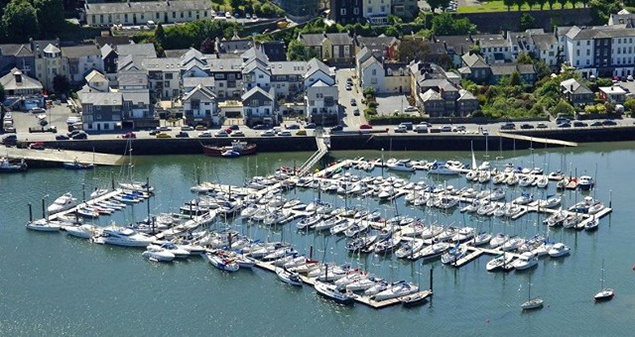 Kinsale is pulling out all the stops to make the Sovereign’s Cup fleet welcome from June 21st to 24th.
Kinsale is pulling out all the stops to make the Sovereign’s Cup fleet welcome from June 21st to 24th.
In fact, Paul Tingle and his counterpart at the Sovereign’s, Kevin Murray of Kinsale, are coming up with all sorts of ingenious suggestions for getting the boats from Crosshaven to Kinsale, ranging from a passage race to a simple offer to provide voluntary delivery crews. The thinking is that some crews and owners will welcome the opportunity for a weekend off to score some brownie points on the home front. But however they get to Kinsale, the participants in the Sovereign’s will find that the entire town is behind the event, which is very much aimed at being a fun happening.
Freed from the constraints of the IRC limitations within ICRA, Kinsale YC can open the door to sportsboats and even inshore keelboat classes, should they be so interested, and the emphasis is going to be very much on a regatta atmosphere rather than the more serious mood of a national championship.
Meanwhile, take note that the Dun Laoghaire to Dingle race is on a Wednesday evening – June 14th – not the Friday evening as in 2015. The feeling is that in these demanding times, it make more sense to slip away from business cares on a Thursday and Friday to get comfortably finished racing by Sunday and probably earlier, rather than arrive in the office exhausted on a Tuesday after a 380-mile race which finished in the small hours of Monday morning. Last time round, it was J boats of several sizes which dominated, with the Shanahan family’s J/109 Ruth winning from sister-ship Mojito, but maybe in 2017 some other marque will get a look in.
For July, an east-west divide arose in planning the programme, when the fascinating concept of a West of Ireland Offshore Racing Association Championship on the Aran islands made the discovery that out in Kilronan, each summer weekend is spoken for in terms of hosting some major island festival. Thus the only clear one they could offer hyper-keen Atlantic Way sailor Cormac MacDonnacha of WIORA was July 8th & 9th, and as his fleet will be wanting to make their way home along the Atlantic seaboard on the Sunday, the WIORA Championship 2017 is July 6th to 8th. It will make for a painful decision for some crews who had hoped to go east for the big one in Dun Laoghaire taking place at exactly the same time.
The Rolex Fastnet Race next year is earlier in August than it has been for some time, going off on Sunday August 6th. And among the fleet will be an Irish boat defending a trophy won in 2015, the Jeanneau 37 Desert Star skippered by Ronan O Siochru of Irish Offshore Sailing of Dun Laoghaire. Desert Star was right on the podium among the many Irish boats in the previous race, and she was also overall winner of the Sailing Schools trophy, besting 32 other boats.
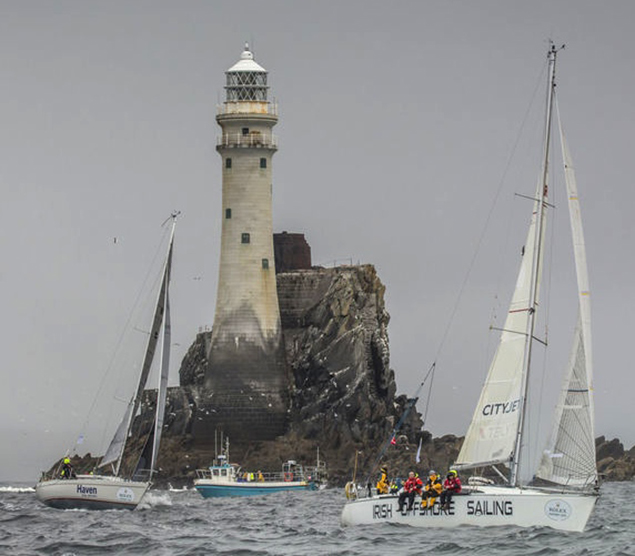 Desert Start round the rock during the Rolex Fastnet Race of 2015, on her way to winning the Sailing Schools Division in a fleet of 33 yachts. Photo: Rolex
Desert Start round the rock during the Rolex Fastnet Race of 2015, on her way to winning the Sailing Schools Division in a fleet of 33 yachts. Photo: Rolex
This was a notable success which underlined just how significant the concept of Fastnet Race experience has become in the definition of genuine seagoing ability. The camaraderie which developed among Desert Star’s crew of rookies from an extraordinary variety of backgrounds was heart-warming to behold, and it’s something which many wish to experience and share.
It’s very much what we hope for 2017, as it’s the perfect example of sailing for more ordinary folk rather than top level competition for superstars. So as we snuggle down into winter with just the special Frostbite, Brass Monkey and Turkey Shoot races available for those who want the occasional quick taste of sailing all year round, spare a thought for those dedicated souls who are so keen to get involved that they’ll go to sea just whenever they can, and that includes going offshore in the depths of winter.
For those dreamily contemplating next season from a comfortable armchair in front of a roaring fire, here’s a thought-provoking email I received last Sunday from Ronan O Siochru:
“We are flying downwind with a poled-out headsail
and double reefed main, 30 knots behind us in absolutely glorious sunshine
from Kilkeel back to Dun Laoghaire.
The guys are after sailing 500 miles in six days, and have been to Wales, the Isle
of Man, England, and Northern Ireland. We have also experienced the raw energy
of the North Channel and the Scottish sea state in November as we headed up to
Cambeltown on the Mull of Kintyre.
They are getting some of the most intense, gruelling training in difficult conditions - cold, 16 hours of darkness each day, and sometimes very fast-changing weather. We haven’t seen another sailing boat in 500 miles, as we left Dun Laoghaire in the dark and haven’t been back since.
They are doing serious training, and are learning so fast they are really closing in on many so called 'experienced’ sailors who have been sailing for decades.
They are an interesting group coming from a variety of backgrounds, a
totally international crew, and all guys on this occasion - Irish, French, English, Italian and a Canadian. Their reasons for being here range from a Canadian naval architect looking to learn to
sail, to a Frenchman taking early retirement with a dream to cash in his
pension to buy a catamaran and do charters in the Caribbean.
And there are a few young bucks
keen to avoid university, and instead sink their teeth into a grittier more active
career……The course has been running since 3rd September, and culminates in the RYA
Yachtmaster Offshore exam on the 26th November. Meanwhile, roll on 2017. The Fastnet calls.”
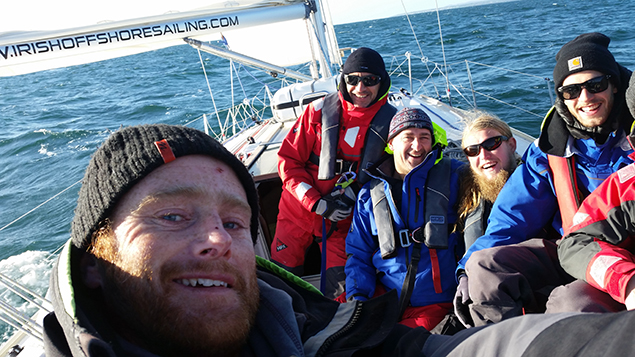 A selfie by Fastnet Race class winner Ronan o Siochru with his crew of trainee yachtmasters as they experience their first easy sailing on the final leg last Sunday from Kilkeel to Dun Laoghaire.
A selfie by Fastnet Race class winner Ronan o Siochru with his crew of trainee yachtmasters as they experience their first easy sailing on the final leg last Sunday from Kilkeel to Dun Laoghaire.


























